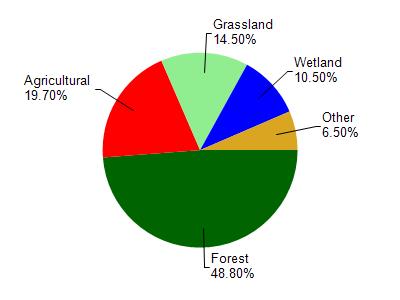Barron
No
No
Yes
Fish and Aquatic Life
Overview
Ths stream drains to the Chetek lakes. This stream is classified as supporting Class II trout, but is degraded by cropland erosion, flooding, beaver dams and barnyard runoff.
Date 1996
Author Aquatic Biologist
Historical Description
Source: 1964, Surface Water Resources of Barron County Pokegama Lake T33N, R10W, Sections 17, 18, 20
A soft water drainage lake in the Chetek Lake Chain between Mud Lake and Lake Chetek. The water level is maintained by the water control structure on the outlet of Lake Chetek. The fish population consists of northern pike, walleyes, largemouth bass, smallmouth bass, perch, bluegills, black crappies, rock bass, pumpkinseeds, bullheads and white suckers. Excessive algae growth is a problem to its use and management. The immediate lakeshore vegetation is pine and hardwood with the exception of several marsh-edged bays. These marshes provide habitat for muskrats and nesting puddle ducks. The lake has nine resorts, nine boat liveries and 109 cottages and dwellings, mainly on the south and northwest shores. It is accessible by two public boat landings and five other undeveloped platted access points, providing a total of 0.07 miles of public frontage.
Surface Acres = 494.0, S.D.F. = 3.56, Maximum Depth = 19 feet
Date 1964
Author Surface Water Inventory Of Wisconsin
Impaired Waters
Pokegama Lake was recently evaluated during the ten-year period of 2009 through 2018 for results that were reported to the USEPA for the 2020 Clean Water Act condition report. The waterbody is considered impaired, or in poor condition for designated uses which include the quality of fish and aquatic life, recreational use, and public health and welfare (fish consumption and related). Pollutants or problems encountered during sampling (impairments) are determined based on water quality standards outlined in Wisconsin 2020 Consolidated Assessment and Listing Methodology (WisCALM). Assessment results show water conditions that are potentially harmful for Aquatic Life use due to values for chlorophyll that fall into the range expected for an aquatic community in poor health, therefore this water is listed as impaired.
Assessment results during the 2020 listing cycle show continued impairment. Chlorophyll levels were too high for both Recreation use and Aquatic Life use according to 2020 WisCALM standards. Based on the most updated information, excess algal growth was added to the existing impairment of eutrophication and Pokegama Lake was changed to a category 5W water because it is covered by the DNR approved watershed restoration plan �A Water Quality Strategy for the Land and Waters of the Red Cedar River Basin.�
Date 2019
Author Ashley Beranek
Condition
Wisconsin has over 84,000 miles of streams, 15,000 lakes and milllions of acres of wetlands. Assessing the condition of this vast amount of water is challenging. The state's water monitoring program uses a media-based, cross-program approach to analyze water condition. An updated monitoring strategy (2015-2020) is now available. Compliance with Clean Water Act fishable, swimmable standards are located in the Executive Summary of Water Condition in 2018. See also the 'monitoring and projects' tab.
Reports
Management Goals
Wisconsin's Water Quality Standards provide qualitative and quantitative goals for waters that are protective of Fishable, Swimmable conditions [Learn more]. Waters that do not meet water quality standards are considered impaired and restoration actions are planned and carried out until the water is once again fishable and swimmable
Management goals can include creation or implementation of a Total Maximum Daily Load analysis, a Nine Key Element Plan, or other restoration work, education and outreach and more. If specific recommendations exist for this water, they will be displayed below online.
Monitoring
Monitoring the condition of a river, stream, or lake includes gathering physical, chemical, biological, and habitat data. Comprehensive studies often gather all these parameters in great detail, while lighter assessment events will involve sampling physical, chemical and biological data such as macroinvertebrates. Aquatic macroinvertebrates and fish communities integrate watershed or catchment condition, providing great insight into overall ecosystem health. Chemical and habitat parameters tell researchers more about human induced problems including contaminated runoff, point source dischargers, or habitat issues that foster or limit the potential of aquatic communities to thrive in a given area. Wisconsin's Water Monitoring Strategy was recenty updated.
Grants and Management Projects
Monitoring Projects
| WBIC | Official Waterbody Name | Station ID | Station Name | Earliest Fieldwork Date | Latest Fieldwork Date | View Station | View Data |
|---|
| 2094300 | Pokegama Lake | 10041626 | Pokegama Lake Access | | | Map | Data |
| 2094300 | Pokegama Lake | 10018512 | Pokegama Lake -- Access at County Road D | 9/20/1995 | 6/10/2017 | Map | Data |
| 2094300 | Pokegama Lake | 10000763 | Pokegama Lake | 9/5/2000 | 10/3/2016 | Map | Data |
| 5583870 | Unnamed | 10041882 | Unnamed Lake (WBIC 5583870) | 8/30/2012 | 10/3/2016 | Map | Data |
| 2094300 | Pokegama Lake | 033151 | Pokegama Lake - Deep Hole - SE Of Island | 7/4/1987 | 10/10/2024 | Map | Data |
| 2094300 | Pokegama Lake | 10030188 | Pokegama Lake at CTH D Boardwalk | 8/8/2007 | 7/5/2019 | Map | Data |
|

Watershed Characteristics
Pokegama Lake is located in the Lake Chetek watershed which is 212.00 mi². Land use in the watershed is primarily forest (48.80%), agricultural (19.70%) and a mix of grassland (14.50%) and other uses (17.00%). This watershed has 270.25 stream miles, 2,008.86 lake acres and 10,678.22 wetland acres.
Nonpoint Source Characteristics
This watershed is ranked Medium for runoff impacts on streams, High for runoff impacts on lakes and High for runoff impacts on groundwater and therefore has an overall rank of High. This value can be used in ranking the watershed or individual waterbodies for grant funding under state and county programs.However, all waters are affected by diffuse pollutant sources regardless of initial water quality. Applications for specific runoff projects under state or county grant programs may be pursued. For more information, go to surface water program grants.